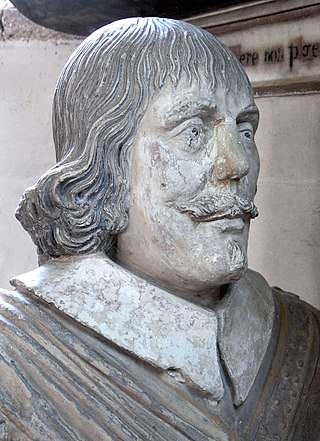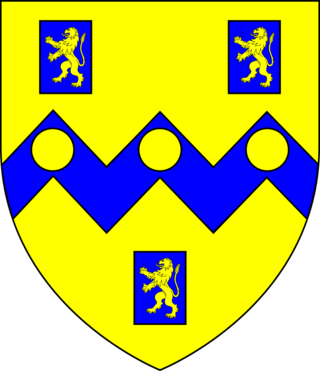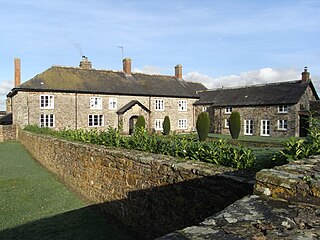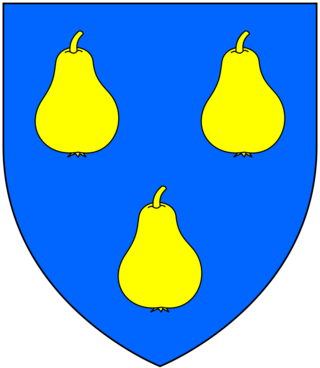
Sir Hugh Pollard (fl. 1536, 1545) lord of the manor of King's Nympton in Devon, was Sheriff of Devon in 1535/6 [2] and in 1545 was appointed Recorder of Barnstaple in Devon. [3]

Sir Hugh Pollard (fl. 1536, 1545) lord of the manor of King's Nympton in Devon, was Sheriff of Devon in 1535/6 [2] and in 1545 was appointed Recorder of Barnstaple in Devon. [3]
He was the eldest son and heir of Sir Lewis Pollard (c.1465–1526) of King's Nympton, a Justice of the Common Pleas from 1514 to 1526 [4] and Member of Parliament for Totnes in 1491. Hugh's mother was Agnes Hext, daughter of Thomas Hext, a prominent lawyer [5] of Kingston in the parish of Staverton, near Totnes, by his wife Florence Bonville. Westcote stated her to be the heiress of Dunisford (or Donesford). [6] The Pollard family were first established in Devon before the 13th century at the manor of Way in the parish of St Giles in the Wood, near Great Torrington.
Hugh's younger brother was the more prominent Sir Richard Pollard (1505–1542), MP for Taunton (1536) and for Devon (1539, 1542), of Putney, Surrey, King's Remembrancer of the Exchequer and a law reporter, [7] who was an assistant of Thomas Cromwell in administering the surrender of religious houses following the Dissolution of the Monasteries. [8] In 1537 Thomas was granted by King Henry VIII the manor of Combe Martin in Devon [9] and in 1540 Forde Abbey.
He was Recorder of Barnstaple in 1545, to which honorary officer the Borough of Barnstaple entrusted the nominations of its two Member of Parliament. [10] One of the MP's he nominated was George Rolle (d.1552), a London lawyer, who in 1523 had been appointed by an act of Parliament, the Keeper of Common Bench Records (Tenure of Office) Act 1523 (14 & 15 Hen. 8. c. 35), as life tenant of the office of "Keeper of the Writs and Rolls of the Court of Common Pleas", due to his "long good and perfect knowledge and experience" of the functioning of that Court. Rolle was thus an associate of Sir Hugh's father, Sir Lewis Pollard, one of the Judges of the Common Pleas. It was in the small Devonshire parish of St Giles in the Wood, the ancestral home of the Pollards, where Rolle purchased his seat of Stevenstone, which eventually at the start of the 20th century became the caput of "the largest estate Devon had ever seen", [11] today managed by the Clinton Devon Estates company.
Through the influence of his younger brother Sir Richard Pollard he obtained the wardship of Richard Bury (1516–1543), son and heir of John Bury (d.1533) lord of the manor of Colleton in the parish of Chulmleigh, Devon, whom he married to his daughter Elizabeth Pollard. Richard Pollard obtained as his own wife John Bury's daughter Jacquetta, as promised him in her father's will. [12]
In 1539 Hugh Pollard acquired a 21-year lease of the site and demesne of Torre Abbey at the Dissolution of the Monasteries, and in 1543 acquired the freehold from John St. Leger (d.1596) of Annery. [13]
He married twice: [14]

Sir John Northcote, 1st Baronet was an English politician who sat in the House of Commons at various times between 1640 and 1676. He supported the Parliamentarian cause in the English Civil War.

Sir John Rolle, KB, of Stevenstone, Devon, was an English landowner, Sheriff of Devon in 1682 and MP for Barnstaple (1660) and for Devon (1661–1679). The Travel Journal of Cosimo III de' Medici, Grand Duke of Tuscany (1642-1723) states of him: "This gentleman is one of the richest in the country, having an estate of six thousand pounds sterling per annum, besides a considerable property in ready money".

Sir Hugh Pollard, 2nd Baronet was an English soldier and MP elected for Bere Alston in 1640, Callington in 1660, and Devon in 1661. He supported the Royalist cause in the English Civil War.

Sir Lewis Pollard his will was of 1526 when he retired of Grilstone in the parish of Bishop's Nympton, Devon, was Justice of the Common Pleas from 1514 to 1526 and served as MP for Totnes in 1491 and was a JP in Devon in 1492. He was knighted after 1509. He was one of several Devonshire men to be "innated with a genius to study law", as identified by Fuller, who became eminent lawyers at a national level. He was a kinsman of the judge and Speaker of the House of Commons Sir John Pollard.

Sir Richard Pollard, was Member of Parliament for Taunton in 1536, and for Devon in 1540 and 1542. He played a major role in assisting Thomas Cromwell in administering the Dissolution of the monasteries.

George Rolle of Stevenstone in the parish of St Giles in the Wood near Great Torrington in Devon, was the founder of the wealthy, influential and widespread Rolle family of Devon, who by 1842 had become the largest landowners in Devon with about 55,000 acres according to the Return of Owners of Land, 1873 in the person of Hon. Mark Rolle, the adoptive heir of John Rolle, 1st Baron Rolle. He was a Dorset-born London lawyer who in 1507 became Keeper of the Records of the Court of Common Pleas and was elected as a Member of Parliament for Barnstaple in 1542 and 1545. He became the steward of Dunkeswell Abbey in Devon, and following the Dissolution of the Monasteries he purchased much ex-monastic land in Devon. Not only was he the founder of his own great Devonshire landowning dynasty but he was also an ancestor of others almost as great, including the Acland baronets of Killerton, the Wrey Baronets of Tawstock and the Trefusis family of Trefusis in Cornwall now of Heanton Satchville, Huish, later Baron Clinton, heirs both of Rolle of Heanton Satchville, Petrockstowe and of Rolle of Stevenstone.

Hall is a large estate within the parish and former manor of Bishop's Tawton, Devon. It was for several centuries the seat of a younger branch of the prominent and ancient North Devon family of Chichester of Raleigh, near Barnstaple. The mansion house is situated about 2 miles south-east of the village of Bishop's Tawton and 4 miles south-east of Barnstaple, and sits on a south facing slope of the valley of the River Taw, overlooking the river towards the village of Atherington. The house and about 2,500 acres of surrounding land continues today to be owned and occupied by descendants, via a female line, of the Chichester family. The present Grade II* listed neo-Jacobean house was built by Robert Chichester between 1844 and 1847 and replaced an earlier building. Near the house to the south at the crossroads of Herner the Chichester family erected in the 1880s a private chapel of ease which contains mediaeval woodwork saved from the demolished Old Guildhall in Barnstaple.

Brightley was historically the principal secondary estate within the parish and former manor of Chittlehampton in the county of Devon, England, situated about 2 1/4 miles south-west of the church and on a hillside above the River Taw. From the early 16th century to 1715 it was the seat of the Giffard family, whose mansion house occupied the moated site immediately to the west of the present large farmhouse known as Brightley Barton, a Grade II listed building which incorporates some elements of the earlier house. It is not to be confused with the 12th-century Brightley Priory near Okehampton.

The landed gentry and nobility of Devonshire, like the rest of the English and European gentry, bore heraldic arms from the start of the age of heraldry circa 1200–1215. The fashion for the display of heraldry ceased about the end of the Victorian era (1901) by which time most of the ancient arms-bearing families of Devonshire had died out, moved away or parted with their landed estates.

The Manor of King's Nympton was a manor largely co-terminous with the parish of King's Nympton in Devon, England.
The Manor of Combe Martin was a medieval manor estate in Combe Martin, Devon, England.

Beam is an historic estate in the parish of Great Torrington, Devon, England. Beam House is situated about 1 1/2 miles north-west and downstream of that town, on the right-bank of the River Torridge. Both the Rolle Canal and the railway crossed the river nearby. It occupies a particularly beautiful setting, described by Lauder (1986) thus: "For lovers of rivers and woodland there can be few lovlier settings for a house than this. Steeply wooded banks shelter the valley and the house is situated on slightly higher ground above lush water meadows, almost completely surrounded by the Torridge" The estate was a subsidiary seat of the Rolle family, lords of the manor of Great Torrington, whose main seat was Stevenstone on the other (south) side of that town and therefore upstream from Beam. It was an outpost of the Royalists during the Civil War. Much of the estate is today owned by Baron Clinton, as heir to the Rolles, but it has had many occupants, including use by the army in both world wars and as a borstal. Tarka the Otter was born at Beam, by what the author Henry Williamson called the "Canal Bridge" and particularly favoured the River Torridge at Beam Weir. Thus the cycleway which crosses the river at Beam, formerly the railway line, was named the "Tarka Trail", due to its association with these and other haunts of the fictional animal. Today Beam is used as an adventure centre for young people.

John Rolle (1679–1730) of Stevenstone and Bicton in Devon, was a British landowner and Tory politician who sat in the English House of Commons from 1703 to 1705 and in the British House of Commons from 1710 to 1730. He declined the offer of an earldom by Queen Anne, but 18 years after his death his eldest son was raised to the peerage in 1748 by King George II as Baron Rolle.

Hudscott is a historic estate within the parish and former manor of Chittlehampton, Devon. From 1700 it became a seat of a junior branch of the influential Rolle family of Heanton Satchville, Petrockstowe and in 1779 became a secondary seat of the senior Rolle family of Stevenstone, then the largest landowner in Devon. Hudscott House, classified in 1967 a Grade II* listed building, is situated one mile south-east of the village of Chittlehampton. It was largely rebuilt in the 17th century by the Lovering family and in the late 17th century became a refuge for ejected Presbyterial ministers. In 1737 its then occupant Samuel II Rolle (1703-1747) purchased the manor of Chittlehampton and thus Hudscott House became in effect the manor house of Chittlehampton.

Langley was a historic estate in the parish of Yarnscombe, Devon, situated one mile north-east of the village of Yarnscombe. It was long the seat of a junior branch of the Pollard family of Way in the parish of St Giles in the Wood, Devon, 3 miles to the south.

Pill is an historic estate in the parish of Bishop's Tawton, near Barnstaple, in North Devon, England. The surviving 18th-century mansion house known as Pill House is a grade II* listed building situated close to the east bank of the River Taw about 1 mile south of the historic centre of Barnstaple and 1 mile north of Bishop's Tawton Church. It was long a seat of a junior branch of the Chichester family of Hall, Bishop's Tawton. At some time before 1951 it was converted into apartments and is at present in multiple occupation.

The large parish church of St Giles, which is in the village of St Giles in the Wood, Devon, England, came into being in 1309. When it was restored in 1862–3, many monuments were retained, including the monument and effigy of Thomas Chafe of Dodscott, three monumental brasses, of Alenora Pollard, Margaret Rolle of Stevenstone and a small brass of her husband John Rolle (d.1570). There are also 19th- and 20th-century monuments to the Rolle family.

The recorder of Barnstaple was a recorder, a form of senior judicial officer, usually an experienced barrister, within the jurisdiction of the Borough of Barnstaple in Devon. He was usually a member of the local North Devonshire gentry. The position of recorder of any borough carried a great deal of prestige and power of patronage. The recorder of a borough was often entrusted by the mayor and corporation to nominate its Members of Parliament, as was the case with Sir Hugh I Pollard, Recorder of Barnstaple, who in 1545 nominated the two MP's to represent the Borough of Barnstaple. In the 19th century a recorder was the sole judge who presided at a Quarter Sessions of a Borough, a "Court of Record", and was a barrister of at least five years' standing. He fixed the dates of the Quarter Sessions at his own discretion "as long as he holds it once every quarter of a year", or more often if he deemed fit.

Sir Hugh Stucley (1496–1559) was the lord of Affeton in Devon, and Sheriff of Devon in 1545. His third son was Thomas Stukley, known as "The Lusty Stucley".
The manor of Alverdiscott was a manor situated in north Devon, England, which included the village of Alverdiscott.